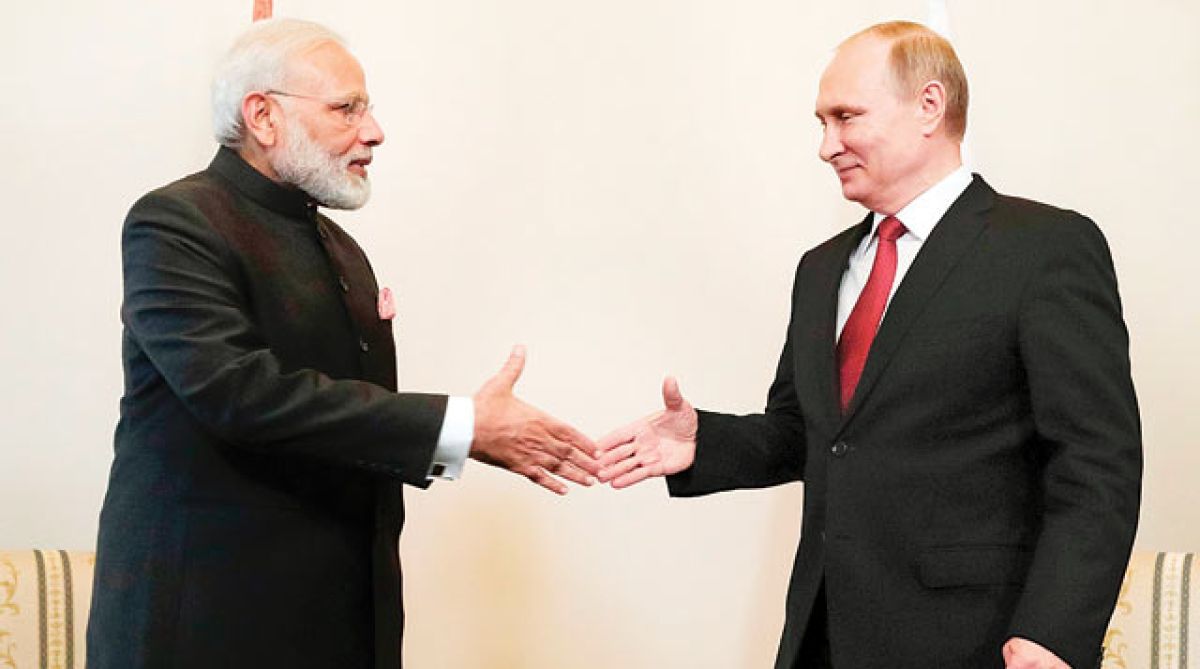After wide-ranging talks between Prime Minister Narendra Modi and President Vladimir Putin, Indian and Russia on October 5 signed the $5 billion S-400 Triumf missile defence system deal in New Delhi, bolstering its shield against possible air attacks from Pakistan and China. They also signed eight other agreements, including one on cooperation in India’s ambitious human space mission project Gaganyaan, at the 19th India-Russia annual bilateral summit. The signing of the defence deal between the two countries comes amidst the US warning that India should not purchase S-100 missiles from Russia.
The Russian-built S-400 Triumf ~ identified by NATO as the SA-21 Growler ~ is the world’s most dangerous operationally deployed modern long-range surface-to-air missile system, and is considered much more effective than the Terminal High Altitude Area Defence system developed by the US.
Advertisement
India’s move to ink the $5.43 billion (Rs 40,000 crore) deal for five advanced S-400 Triumf surface-to-air missile squadrons from Russia on 5 October, despite the looming threat of US sanctions, underlines its resolve to bolster air defence coverage along the unresolved borders with China and Pakistan. The resolve became stronger after China inducted six S-400 batteries in January under a $3 billion deal linked with Russia in 2014. The US last month imposed financial sanctions on China for its S-400 deal but India is hopeful of getting a waiver from the Trump administration, being its close strategic and trade partner. The US also depends on India to counter China in its strategic manoeuvers in South China Sea and other areas.
The S-400 missiles are very critical for India’s national security. In terms of configuration India’s S-400 are better than what China is getting. The highly automated and mobile S-400 systems, with four different kinds of missiles with interception ranges between 150 km and 380 km, will change the dynamics of air defence in the region. However China is getting the older version of S-400.
India will pay only 15 per cent (Rs 6,000 crore) to Russia as the first instalment, with the rest being linked to the cycle of deliveries. IAF is slated to get the first S-400 missile squadron in 24 months, with its associated battle management system of command post and launchers, longrange acquisition and engagement radars, and all terrain transport-erector-launcher vehicles. All five squadrons, with two firing units each, will arrive within 54 months.
The S-400, with their huge ‘area denial capabilities’ are much of a gamechanger. S-400 is certainly more formidable than the US Patriot or any other air defence system around the world. The combination of the Rs 59,000-crore 36 Rafale fighter jets and S-400 missile systems will be a very strong weapon system a force to reckon with India to counter any two-pronged offensive from China and Pakistan.
When deployed near the border with Pakistan it can shoot down a hostile F-16 fighter or cruise missile long before it comes anywhere near Indian air space during hostilities. It can even take out intermediate range ballistic missiles with a velocity of 4,800 meters per second. It will be crucial in providing multilayer defence for cities like Delhi, Mumbai, Chennai and Kolkata.
The issue of whether India has disregarded the US threat of applying sanctions under the Countering America’s Adversaries Through Sanctions Act (CAATSA) after inking $5 billion defence systems deal had dominated the discourse of the Modi- Putin annual summit. Though the US had earlier this week cautioned countries against helping the Russian economy by buying weapon systems from them, India has sealed the deal in view of its urgent national security needs.
American lawmakers, however, have allowed the possibility of a presidential waiver. Hopefully the Trump administration will give a waiver to India considering its dire strategic defence requirements. India has mounted a major diplomatic- military campaign to convince the US to grant a waiver to its acquisition of five squadrons of S-400 Triumf air defence missile systems contract from Russia. India has assured the US that it will not “compromise the operational secrecy” of the weapon systems it has purchased or will buy from the US.
India will have to maintain robust technical firewalls and not pass on sensitive information to a third party. India respects IPR and meticulously adheres to contracts linked with other countries. The US worry is that S-400 systems are capable of “mapping or recording” data of other platforms like aircraft or radars. The Stealth characteristics, electronic warfare and other capabilities of US F-35 fighters can be recorded by S-400 missile systems. Moscow would then be able to access data recorded by S-400 systems if leaked by India or any other country.
Hopefully, Trump realises India’s urgent national security requirement especially when the neighbouring countries are nuclear powered. If sanctions are imposed on India, the US will suffer more than India as the latter is one of its largest trading partners. This may result in considerable economic loss to the US. Moreover, Russia is the major country that has been supporting India at the UN on the Kashmir issue. It has even exercised the veto against adverse verdicts against India. Indo-Russian joint military exercises are being carried out regularly for planning joint strategies.
Speaking on bilateral trade ties, Prime Minister Narendra Modi said that Russia could become our partner in the new and renewable energy sector. He said that the world has changed but the relationship between India and Russia has remained the same and trade between the two countries has risen to 20 per cent in 2017-18.
Agreements were also signed in the fields of nuclear energy, railways and space. A crucial MoU was signed between Indian Space Research Organisation (ISRO) and the Federal Space Agency of Russia ‘ROSCOSMOS’ on joint activities in the field of human spaceflight programme, Gaganyaan. India is planning to send an astronaut to space by 2022 for which Russia is going to be of great help.
President Putin said the two countries have agreed to buttress cooperation in combating the menace of terrorism and drug trafficking. Drug trafficking and terrorism are the most important worries for India. Russia wants Indian energy companies to invest there. Putin and Modi have discussed the Koodankulam nuclear power plant in Tamil Nadu. The fourth and fifth units of the plant are being constructed. The Modi-Putin summit is likely to be a game changer in settling international disputes in the region.
The writer, a retired Professor of International Trade, is author of World Trade Organisation: Implications for Selected Sectors of Indian Economy. He may be reached at vasu022@gmail.com











